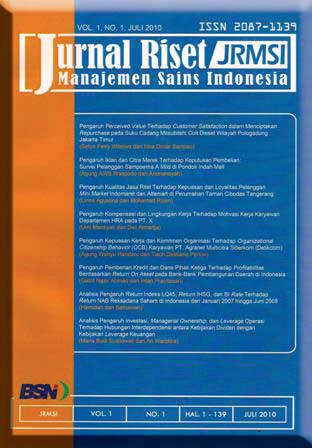PENGARUH PENILAIAN KINERJA DAN BEBAN KERJA TERHADAP KINERJA PEGAWAI DENGAN MOTIVASI SEBAGAI VARIABEL MEDIASI PADA DIREKTORAT SISTEM INFORMASI DAN TEKNOLOGI PERBENDAHARAAN
DOI:
https://doi.org/10.21009/JRMSI.013.1.010Keywords:
Penilaian Kinerja, Beban Kerja, Motivasi Pegawai, Kinerja Pegawai.Abstract
Penelitian ini dilatarbelakangi oleh adanya hasil penilaian kinerja yang kurang memuaskan pada Direktorat Sistem Informasi dan Teknologi Perbendaharaan. Pada kenyataannya kinerja Direktorat SITP sudah banyak dirasakan oleh stake holder. Hal lain yang menjadi perhatian adalah adanya beban kerja yang besar namun tidak mengurangi motivasi pegawai untuk tetap memberikan hasil kinerja yang maksimal. Rumusan masalah pada penelitian ini adalah: (1) bagaimana pengaruh penilaian kinerja terhadap kinerja pegawai; (2) bagaimana pengaruh penilaian kinerja terhadap motivasi kerja karyawan; (3) bagaimana beban kerja mempengaruhi kinerja pegawai; (4) bagaimana beban kerja mempengaruhi motivasi kerja karyawan dan (5) bagaimana motivasi karyawan mempengaruhi kinerja karyawan. Penelitian ini merupakan penelitian kuantitatif. Pengumpulan data dilakukan dengan menyebarkan survei online kepada 135 staf Direktorat SITP pada seluruh Subdirektorat. Analisis data menggunakan model persamaan struktural atau Structural Equation Model (SEM) dengan pengolahan data menggunakan Partial Least Square (PLS) versi 3. Hasil penelitian menunjukkan bahwa: (1) penilaian kinerja berpengaruh positif dan signifikan terhadap kinerja karyawan; (2) penilaian kinerja berpengaruh positif dan signifikan terhadap motivasi kerja karyawan; (3) beban kerja berpengaruh positif dan signifikan terhadap kinerja pegawai; (4) beban kerja berpengaruh positif dan signifikan terhadap motivasi kerja pegawai dan (5) motivasi kerja memberikan mediasi parsial antara penilaian kinerja dan beban kerja terhadap kinerja pegawai.
References
Ayu, S., & Rosli, M. S. Bin. (2020). Uji Reliabilitas Instrumen Penggunaan SPADA (Sistem Pembelajaran dalam Jaringan). Biormatika, 6(1), 145–155.
Balaboniene, I., & Vecerskiene, G. (2015). The aspects of performance measurement in public sector organization. Procedia-Social and Behavioral Sciences, 213, 314–320. https://doi.org/10.1016/j.sbspro.2015.11.544
Bruggen, A. (2015). An empirical investigation of the relationship between workload and performance. Management Decision (Emerald Insight), 53(10).
Caillier, J. G. (2014). Factors affecting job performance in public agencies. Public Performance & Management Review, 34(2), 139–165. https://doi.org/10.2753/PMR1530-9576340201
Crawford, J., Henderson, K. B., Rudolph, J., Malkawi, B., Glowatz, M., Burton, R., Magni, P. A., & Lam, S. (2020). COVID-19 : 20 countries ’ higher education intra-period digital pedagogy responses. Journal of Applied Learning & Teaching, 3(1), 1–20.
Dasgupta, P. R. (2013). Volatility of workload on employee performance and significance of motivation : IT sector. Science Journal of Business and Management, 1(1), 1–7. https://doi.org/10.11648/j.sjbm.20130101.11
Furlich, Stephen A Ph, D. (2016). Understanding employee motivation through managerial communication using expectancy-valence theory. Journal of Integrated Social Sciences, 6(1), 17–37.
Ghozali, I. (2006). Aplikasi analisis multivariate dengan program spss. Badan Penerbit Universitas Diponegoro.
Ghozali, I. (2011). Structural equation modeling metode alternatif dengan partial least square. Badan Penerbit Universitas Diponegoro.
Harwiki, W. (2016). The impact of servant leadership on organization culture, organizational commitment, organizational citizenship behaviour (OCB) and employee performance in women cooperatives. Procedia-Social and Behavioral Sciences, 219, 283–290. https://doi.org/10.1016/j.sbspro.2016.04.032
Hussain, K. (2017). Impact of performance appraisal reactions on affective organizational commitment and work performance. 4(3), 1–6. https://doi.org/10.31580/jei.v4i3.94
Inuwa, M. (2016). Job satisfaction and employee performance : an empirical approach. The Millennium University Journal, 1(1), 90–103.
Iqbal, Ahmad, N., Haider, Z., Batool, Y., & Ain, Q. U. (2013). Impact of performance appraisal on employee ’ s performance involvingthe moderating role of motivation. Arabian Journal of Business and Management Review (OMAN Chapter), 3(1), 37–56.
Irvianti, L. D. S., & Verina, R. E. (2015). Analisis pengaruh stres kerja, beban kerja dan lingkungan kerja terhadap turnover intention karyawan pada pt xl axiata tbk jakarta. Binus Business Review, 6(1), 117–126.
Jaya, I. G. N. M., & Sumertajaya, I. M. (2008). Pemodelan persamaan structural dengan partial least square. Semnas Matematika Dan Pendidikan Matematika 2008, 118–132.
Kasmarani, M. (2012). Pengaruh beban kerja fisik dan mental terhadap stres kerja pada perawat di instalasi gawat darurat (Igd) RSUD Cianjur. Jurnal Kesehatan Masyarakat Universitas Diponegoro, 1(2), 767–776.
Kolk, B. van der, Dirks, P. M. G. van V.-, & Bogt, H. J. ter. (2019). The impact of management control on employee motivation and performance in the public sector. European Accounting Review, 28(5), 901–928. https://doi.org/10.1080/09638180.2018.1553728
Liu, H., Fan, J., Fu, Y., & Liu, F. (2018). Intrinsic motivation as a mediator of the relationship between organizational support and quantitative workload and work-related fatigue. Human Factors and Ergonomics in Manufacturing & Service Industries, 28(3), 1–9. https://doi.org/10.1002/hfm.20731
Manzoor, Q. (2012). Impact of employees motivation on organizational effectiveness. European Journal of Business and Management, 3(3), 36–45.
Masakure, O. (2016). The effect of loyalty on wages. Journal of Economic Psychology, 56, 274–298. https://doi.org/10.1016/j.joep.2016.08.003
Mathis, R. L., & Jackson, J. H. (2012). Manajemen sumber daya manusia. Salemba Empat.
Mehrzi, N. Al, & Singh, S. K. (2016). Competing through employee engagement : a proposed framework. International Journal of Productivity and Performance Management, 65(6), 831–843.
Paais, M., & Pattiruhu, J. R. (2020). Effect of motivation , leadership , and organizational culture on satisfaction and employee performance. Journal of Asian Finance, Economics and Business, 7(8), 577–588. https://doi.org/10.13106/jafeb.2020.vol7.no8.577
Pradhan, R. K., & Jena, L. K. (2017). Employee performance at workplace: conceptual model and empirical validation. Business Perspectives and Research, 5(1), 69–85. https://doi.org/10.1177/2278533716671630
Rifai, A. (2015). Partial least square-structural equation modeling (PLS-SEM) untuk mengukur ekspektasi penggunaan repositori lembaga: pilot studi di UIN syarif hidayatullah jakarta. Al-Maktabah, 14(1), 56–65.
Sari, Y. (2019). How do work stress and workload influence work motivation and performance of employees of the state-owned banks in indonesia? East African Scholars Journal of Economics, Business and Management, 2(6), 333–340. _
Shmailan, A. S. Bin. (2016). The relationship between job satisfaction , job performance and employee engagement : an explorative study. Issues in Business Management and Economics, 4(1), 1–8.
Sok, P., & Cass, A. O. (2011). Industrial marketing management achieving superior innovation-based performance outcomes in SMEs through innovation resource – capability complementarity. Industrial Marketing Management, 40(8), 1285–1293.
Downloads
Published
How to Cite
Issue
Section
License

Articles in Jurnal Riset Manajemen Sains Indonesia are Open Access articles published under the Creative Commons CC BY-NC-SA License. This license permits use, distribution and reproduction in any medium for non-commercial purposes only, provided the original work and source is properly cited. Any derivative of the original must be distributed under the same license as the original.











